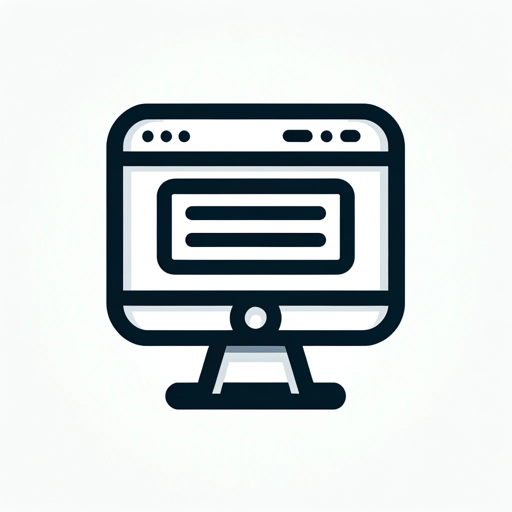website design-website design and customization
AI-powered Website Design Made Easy
Related Tools
Load More
Website Builder
Creative assistant for website building and design ideas.

Website designer - logos, website, email template
I provide digital assets for a business which include logos, website, email template, business cards, merch

Website Design Guru
I guide in improving website UX & design, inspired by tech icons.

Webdesign Assistent
Optimizing web designs with creative flair.

Design Web-Site
Just write what niche you need a website for and what style you prefer

网站设计
Web dev expert in Mandarin, full code snippets, knows phpMyAdmin/BaoTa
20.0 / 5 (200 votes)
Introduction to Website Design
Website design encompasses the planning, conceptualization, and arrangement of content intended for the internet. It combines aesthetics and functionality to create visually appealing and user-friendly websites. This process involves various aspects, including layout, color schemes, typography, images, and interactive features. The goal of website design is to create a seamless user experience that enhances engagement and accessibility. For example, a well-designed e-commerce website can guide a user from browsing products to making a purchase effortlessly, while a news website might prioritize readability and easy navigation for accessing articles.

Main Functions of Website Design
User Interface (UI) Design
Example
Designing a clean, intuitive layout for an online banking platform.
Scenario
A bank wants to improve its online services by making it easier for customers to navigate their accounts. A UI designer creates a dashboard that clearly displays account balances, recent transactions, and quick links to essential features like fund transfers and bill payments.
User Experience (UX) Design
Example
Enhancing the booking process on a travel website.
Scenario
A travel agency aims to increase online bookings by improving the user experience on its website. UX designers streamline the booking process by minimizing the steps required, adding auto-fill options, and ensuring the website is mobile-friendly, resulting in higher conversion rates.
Responsive Design
Example
Creating a website for a restaurant that looks good on both desktops and mobile devices.
Scenario
A restaurant wants a website that potential customers can easily access on any device. Responsive design ensures that the site adapts to different screen sizes, providing an optimal viewing experience whether on a smartphone, tablet, or desktop computer.
Ideal Users of Website Design Services
Small Business Owners
Small business owners benefit from website design services by establishing an online presence that can attract and retain customers. A professionally designed website can help showcase their products or services, provide essential information, and facilitate online transactions, thereby expanding their market reach.
Nonprofit Organizations
Nonprofits use website design services to raise awareness, share their mission, and encourage donations. A well-designed website can effectively communicate the organization's goals, provide updates on projects, and offer a platform for online donations and volunteer sign-ups, enhancing engagement with supporters.

Guidelines for Using Website Design
Visit aichatonline.org
Access the website for a free trial without login, also no need for ChatGPT Plus.
Choose Your Template
Browse through various templates and select one that suits your needs.
Customize the Design
Use the drag-and-drop editor to customize the layout, colors, fonts, and other elements.
Add Content
Insert your text, images, videos, and other content to populate the website.
Publish and Optimize
Preview your website, make any necessary adjustments, and then publish it. Utilize SEO tools for better visibility.
Try other advanced and practical GPTs
Unity Lizard Wizard
AI-powered Unity development assistant

Video Shot List Creator
AI-Powered Shot Lists for Cinematic Videos
OpenWrt VPN Specialist
AI-powered OpenWrt VPN setup support

VPN Helper
AI-powered guidance for VPN creation

GPT Plus
Your AI-powered partner for detailed insights

Habitus Health
AI-Powered Ergonomic Risk Assessment in Minutes

SMM Specialist
AI-Powered Social Media Optimization.

MacOS Specialist
AI-powered Mac coding environment setup

Rewrite Specialist
Elevate Your Writing with AI Precision

Restaurant Specialist
AI-powered tool for personalized dining experiences.

Tokenomics Specialist
AI-powered insights for crypto tokenomics.

Linux Specialist
AI-powered Linux expertise at your fingertips.

- E-commerce
- Business
- Personal
- Portfolio
- Blog
Frequently Asked Questions About Website Design
What types of templates are available?
We offer a variety of templates including business, e-commerce, portfolio, blog, and personal websites.
Can I integrate third-party tools?
Yes, our platform supports integration with various third-party tools such as Google Analytics, social media widgets, and payment gateways.
Is it mobile-friendly?
Absolutely. All our templates are responsive and optimized for mobile devices to ensure a seamless user experience.
How do I ensure my website is SEO-friendly?
Our platform includes built-in SEO tools that guide you through optimizing your site’s content, meta tags, and overall structure for better search engine ranking.
Can I edit my website after publishing?
Yes, you can continuously update and edit your website even after it’s published, ensuring it remains current and effective.